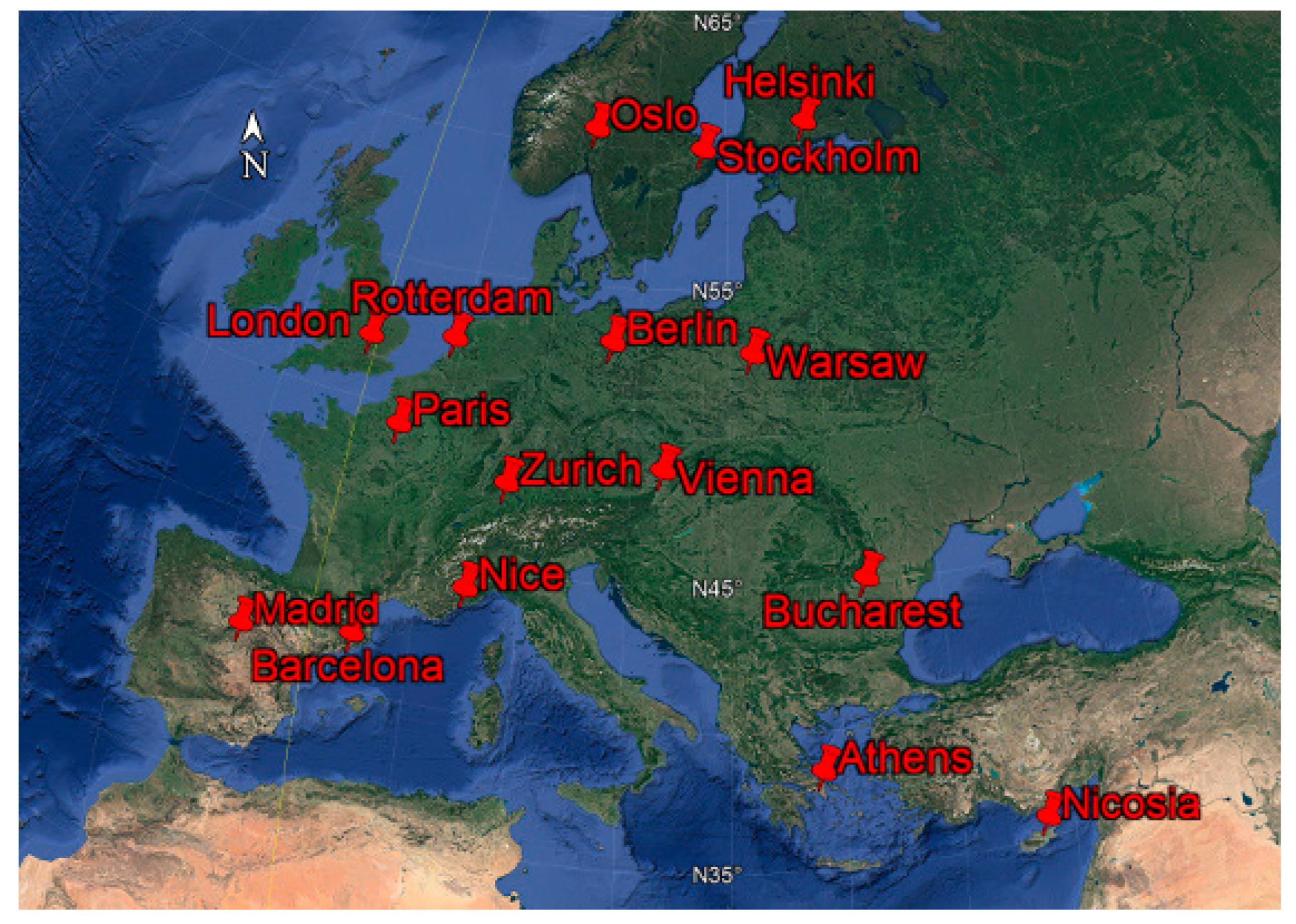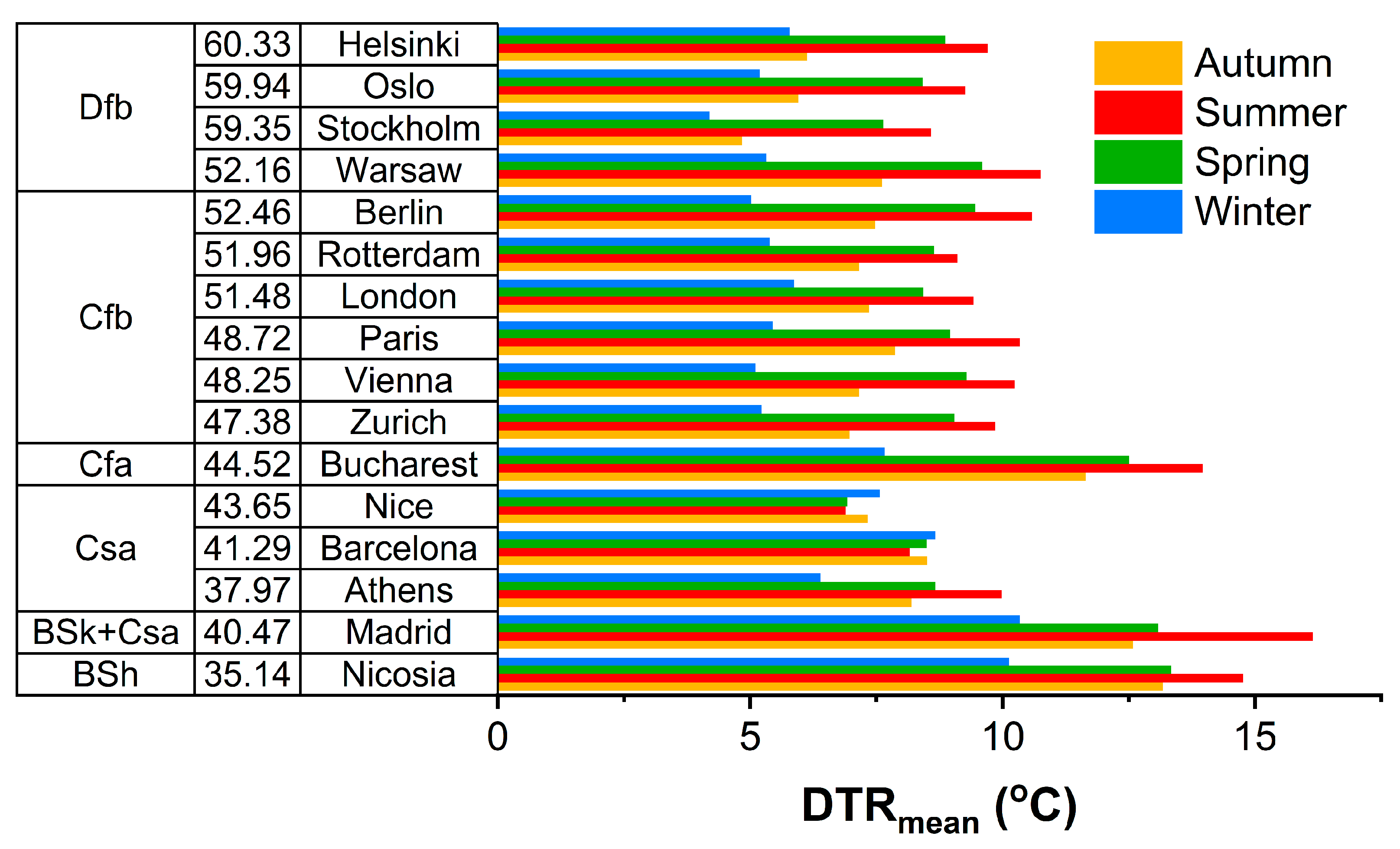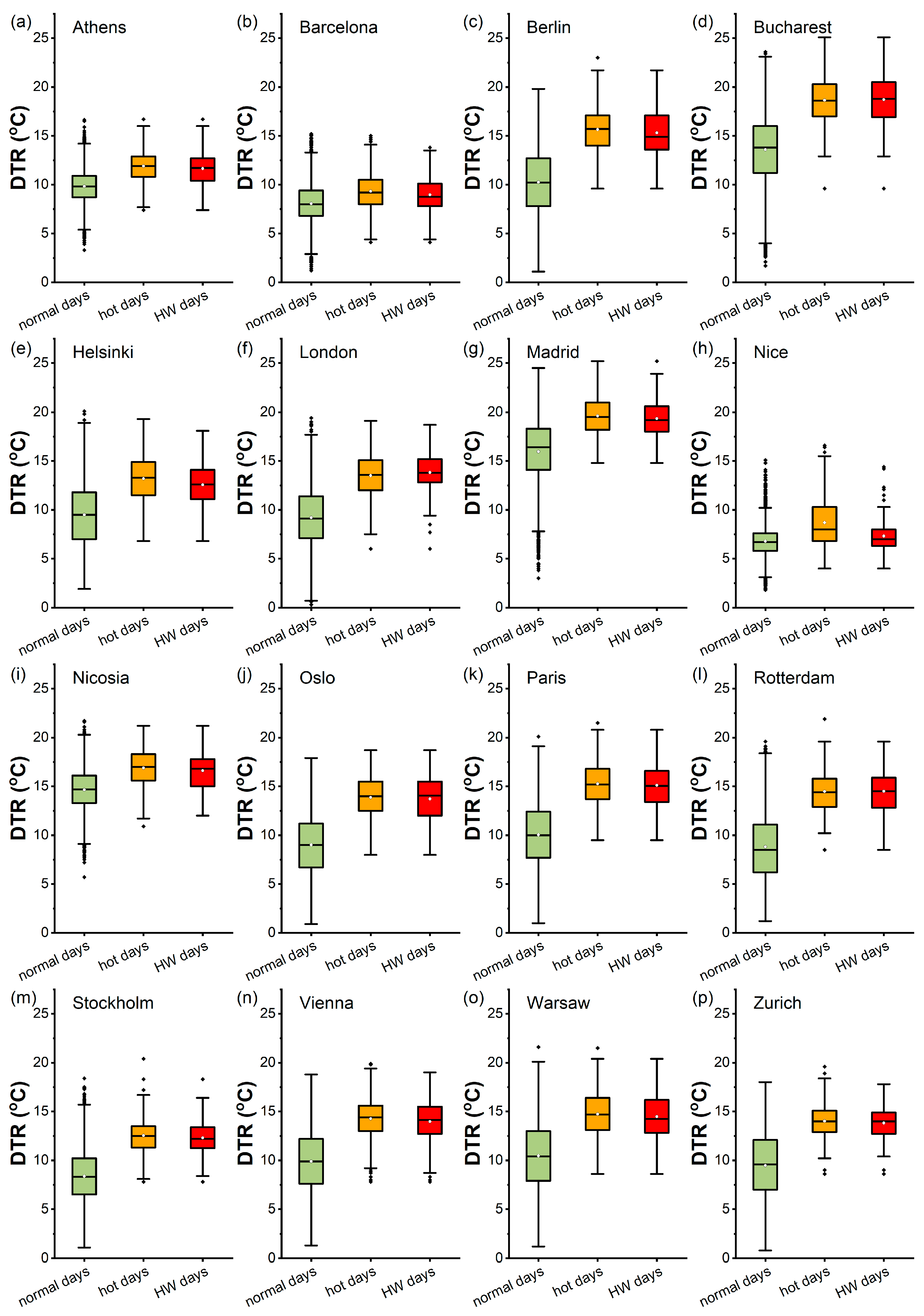Diurnal Temperature Range and Its Response to Heat Waves in 16 European Cities—Current and Future Trends
Abstract
:1. Introduction
2. Materials and Methods
2.1. Studied Cities and Observational Data
2.2. RCM Simulations
2.3. Analysis
3. Results
3.1. Distribution of DTR Based on Observations (1961–2019) per Climate Type
3.2. Seasonal Variation of Mean DTR Based on Observations (1961–2019)
3.3. Response of DTR to Exceptionally Hot Weather
3.4. Trends in the Projected DTR (1971–2100)
3.5. Seasonal Variation in DTR under Climate Change
3.6. Response of DTR to Exceptionally Hot Weather in the Future
4. Discussion and Conclusions
Author Contributions
Funding
Institutional Review Board Statement
Informed Consent Statement
Data Availability Statement
Acknowledgments
Conflicts of Interest
References
- IPCC. Climate Change 2021: The Physical Science Basis; Contribution of Working Group I to the Sixth Assessment Report of the Intergovernmental Panel on Climate Change; Masson-Delmotte, V., Zhai, P., Pirani, A., Connors, S.L., Péan, C., Berger, S., Caud, N., Chen, Y., Goldfarb, L., Gomis, M.I., et al., Eds.; Cambridge University Press: Cambridge, UK; New York, NY, USA, 2021; p. 239. [Google Scholar] [CrossRef]
- Zhang, X.; Alexander, L.; Hegerl, G.C.; Jones, P.; Tank, A.K.; Peterson, T.C.; Trewin, B.; Zwiers, F.W. Indices for Monitoring Changes in Extremes Based on Daily Temperature and Precipitation Data. Wiley Interdiscip. Rev. Clim. Chang. 2011, 2, 851–870. [Google Scholar] [CrossRef]
- Braganza, K.; Karoly, D.J.; Arblaster, J.M. Diurnal Temperature Range as an Index of Global Climate Change during the Twentieth Century. Geophys. Res. Lett. 2004, 31, L13217. [Google Scholar] [CrossRef]
- Lee, W.; Kim, Y.; Sera, F.; Gasparrini, A.; Park, R.; Choi, H.M.; Prifti, K.; Bell, M.L.; Abrutzky, R.; Guo, Y.; et al. Projections of Excess Mortality Related to Diurnal Temperature Range under Climate Change Scenarios: A Multi-Country Modelling Study. Lancet Planet. Health 2020, 4, e512–e521. [Google Scholar] [CrossRef] [PubMed]
- Wang, Z.; Zhou, Y.; Luo, M.; Yang, H.; Xiao, S.; Huang, X.; Ou, Y.; Zhang, Y.; Duan, X.; Hu, W.; et al. Association of Diurnal Temperature Range with Daily Hospitalization for Exacerbation of Chronic Respiratory Diseases in 21 Cities, China. Respir. Res. 2020, 21, 251. [Google Scholar] [CrossRef]
- Davis, R.E.; Hondula, D.M.; Sharif, H. Examining the diurnal temperature range enigma: Why is human health related to the daily change in temperature? Int. J. Biometeorol. 2020, 64, 397–407. [Google Scholar] [CrossRef]
- Huang, Y.; Jiang, N.; Shen, M.; Guo, L. Effect of Preseason Diurnal Temperature Range on the Start of Vegetation Growing Season in the Northern Hemisphere. Ecol. Indic. 2020, 112, 106161. [Google Scholar] [CrossRef]
- Lobell, D.B. Changes in Diurnal Temperature Range and National Cereal Yields. Agric. For. Meteorol. 2007, 145, 229–238. [Google Scholar] [CrossRef]
- Adekanmbi, A.A.; Sizmur, T. Importance of Diurnal Temperature Range (DTR) for Predicting the Temperature Sensitivity of Soil Respiration. Front. Soil Sci. 2022, 2, 969077. [Google Scholar] [CrossRef]
- Bravo Dias, J.; Soares, P.M.M.; Carrilho da Graça, G. The Shape of Days to Come: Effects of Climate Change on Low Energy Buildings. Build. Environ. 2020, 181, 107125. [Google Scholar] [CrossRef]
- Wang, K.; Ye, H.; Chen, F.; Xiong, Y.; Wang, C. Urbanization Effect on the Diurnal Temperature Range: Different Roles under Solar Dimming and Brightening. J. Clim. 2012, 25, 1022–1027. [Google Scholar] [CrossRef]
- Ren, G.; Zhou, Y. Urbanization Effect on Trends of Extreme Temperature Indices of National Stations over Mainland China, 1961–2008. J. Clim. 2014, 27, 2340–2360. [Google Scholar] [CrossRef]
- Karl, T.R.; Kukla, G.; Gavin, J. Recent Temperature Changes during Overcast and Clear Skies in the United States. J. Appl. Meteorol. Climatol. 1987, 26, 698–711. [Google Scholar] [CrossRef]
- Dai, A.; Trenberth, K.E.; Karl, T.R. Effects of Clouds, Soil Moisture, Precipitation, and Water Vapor on Diurnal Temperature Range. J. Clim. 1999, 12, 2451–2473. [Google Scholar] [CrossRef]
- Shen, X.; Liu, B.; Lu, X. Effects of Land Use/Land Cover on Diurnal Temperature Range in the Temperate Grassland Region of China. Sci. Total Environ. 2017, 575, 1211–1218. [Google Scholar] [CrossRef] [PubMed]
- Schultz, N.M.; Lawrence, P.J.; Lee, X. Global Satellite Data Highlights the Diurnal Asymmetry of the Surface Temperature Response to Deforestation. J. Geophys. Res. Biogeosci. 2017, 122, 903–917. [Google Scholar] [CrossRef]
- He, B.; Huang, L.; Wang, Q. Precipitation Deficits Increase High Diurnal Temperature Range Extremes. Sci. Rep. 2015, 5, 12004. [Google Scholar] [CrossRef] [PubMed]
- Sun, X.; Wang, C.; Ren, G. Changes in the Diurnal Temperature Range over East Asia from 1901 to 2018 and Its Relationship with Precipitation. Clim. Chang. 2021, 166, 44. [Google Scholar] [CrossRef]
- Vose, R.S.; Easterling, D.R.; Gleason, B. Maximum and Minimum Temperature Trends for the Globe: An Update through 2004. Geophys. Res. Lett. 2005, 32, L23822. [Google Scholar] [CrossRef]
- Thorne, P.W.; Menne, M.J.; Williams, C.N.; Rennie, J.J.; Lawrimore, J.H.; Vose, R.S.; Peterson, T.C.; Durre, I.; Davy, R.; Esau, I.; et al. Reassessing Changes in Diurnal Temperature Range: A New Data Set and Characterization of Data Biases. J. Geophys. Res. Atmos. 2016, 121, 5115–5137. [Google Scholar] [CrossRef]
- Sun, X.; Ren, G.; You, Q.; Ren, Y.; Xu, W.; Xue, X.; Zhan, Y.; Zhang, S.; Zhang, P. Global Diurnal Temperature Range (DTR) Changes since 1901. Clim. Dyn. 2019, 52, 3343–3356. [Google Scholar] [CrossRef]
- Tank, A.M.G.K.; Können, G.P. Trends in Indices of Daily Temperature and Precipitation Extremes in Europe, 1946–1999. J. Clim. 2003, 16, 3665–3680. [Google Scholar] [CrossRef]
- Jaagus, J.; Briede, A.; Rimkus, E.; Remm, K. Variability and Trends in Daily Minimum and Maximum Temperatures and in the Diurnal Temperature Range in Lithuania, Latvia and Estonia in 1951–2010. Theor. Appl. Climatol. 2014, 118, 57–68. [Google Scholar] [CrossRef]
- Karl, T.R.; Kukla, G.; Razuvayev, V.N.; Changery, M.J.; Quayle, R.G.; Heim, R.R., Jr.; Easterling, D.R.; Fu, C.B. Global Warming: Evidence for Asymmetric Diurnal Temperature Change. Geophys. Res. Lett. 1991, 18, 2253–2256. [Google Scholar] [CrossRef]
- Qu, M.; Wan, J.; Hao, X. Analysis of Diurnal Air Temperature Range Change in the Continental United States. Weather Clim. Extrem. 2014, 4, 86–95. [Google Scholar] [CrossRef]
- Doan, Q.-V.; Chen, F.; Asano, Y.; Gu, Y.; Nishi, A.; Kusaka, H.; Niyogi, D. Causes for Asymmetric Warming of Sub-Diurnal Temperature Responding to Global Warming. Geophys. Res. Lett. 2022, 49, e2022GL100029. [Google Scholar] [CrossRef]
- You, Q.; Min, J.; Jiao, Y.; Sillanpää, M.; Kang, S. Observed Trend of Diurnal Temperature Range in the Tibetan Plateau in Recent Decades. Int. J. Climatol. 2016, 36, 2633–2643. [Google Scholar] [CrossRef]
- Zhang, X.; Vincent, L.A.; Hogg, W.D.; Niitsoo, A. Temperature and Precipitation Trends in Canada during the 20th Century. Atmos. Ocean 2000, 38, 395–429. [Google Scholar] [CrossRef]
- Makowski, K.; Wild, M.; Ohmura, A. Diurnal Temperature Range over Europe between 1950 and 2005. Atmos. Chem. Phys. 2008, 8, 6483–6498. [Google Scholar] [CrossRef]
- Shahid, S.; Harun, S.B.; Katimon, A. Changes in Diurnal Temperature Range in Bangladesh during the Time Period 1961–2008. Atmos. Res. 2012, 118, 260–270. [Google Scholar] [CrossRef]
- Jhajharia, D.; Singh, V.P. Trends in Temperature, Diurnal Temperature Range and Sunshine Duration in Northeast India. Int. J. Climatol. 2011, 31, 1353–1367. [Google Scholar] [CrossRef]
- Mall, R.K.; Chaturvedi, M.; Singh, N.; Bhatla, R.; Singh, R.S.; Gupta, A.; Niyogi, D. Evidence of Asymmetric Change in Diurnal Temperature Range in Recent Decades over Different Agro-Climatic Zones of India. Int. J. Climatol. 2021, 41, 2597–2610. [Google Scholar] [CrossRef]
- Del Río, S.; Cano-Ortiz, A.; Herrero, L.; Penas, A. Recent Trends in Mean Maximum and Minimum Air Temperatures over Spain (1961–2006). Theor. Appl. Climatol. 2012, 109, 605–626. [Google Scholar] [CrossRef]
- Zhou, L.; Dickinson, R.E.; Dirmeyer, P.; Dai, A.; Min, S.-K. Spatiotemporal Patterns of Changes in Maximum and Minimum Temperatures in Multi-Model Simulations. Geophys. Res. Lett. 2009, 36, L02702. [Google Scholar] [CrossRef]
- Wang, K.; Clow, G.D. The Diurnal Temperature Range in CMIP6 Models: Climatology, Variability, and Evolution. J. Clim. 2020, 33, 8261–8279. [Google Scholar] [CrossRef]
- Perkins-Kirkpatrick, S.E.; Lewis, S.C. Increasing Trends in Regional Heatwaves. Nat. Commun. 2020, 11, 3357. [Google Scholar] [CrossRef] [PubMed]
- Founda, D.; Katavoutas, G.; Pierros, F.; Mihalopoulos, N. Centennial Changes in Heat Waves Characteristics in Athens (Greece) from Multiple Definitions Based on Climatic and Bioclimatic Indices. Glob. Planet. Chang. 2022, 212, 103807. [Google Scholar] [CrossRef]
- Katavoutas, G.; Founda, D. Intensification of Thermal Risk in Mediterranean Climates: Evidence from the Comparison of Rational and Simple Indices. Int. J. Biometeorol. 2019, 63, 1251–1264. [Google Scholar] [CrossRef]
- Katavoutas, G.; Founda, D.; Varotsos, K.V.; Giannakopoulos, C. Climate Change Impacts on Thermal Stress in Four Climatically Diverse European Cities. Int. J. Biometeorol. 2022, 66, 2339–2355. [Google Scholar] [CrossRef]
- Katavoutas, G.; Georgiou, G.K.; Asimakopoulos, D.N. Studying the urban thermal environment under a human-biometeorological point of view: The case of a large coastal metropolitan city, Athens. Atmos. Res. 2015, 152, 82–92. [Google Scholar] [CrossRef]
- Kueh, M.-T.; Lin, C.-Y.; Chuang, Y.-J.; Sheng, Y.-F.; Chien, Y.-Y. Climate Variability of Heat Waves and Their Associated Diurnal Temperature Range Variations in Taiwan. Environ. Res. Lett. 2017, 12, 074017. [Google Scholar] [CrossRef]
- Kottek, M.; Grieser, J.; Beck, C.; Rudolf, B.; Rubel, F. World Map of the Köppen-Geiger Climate Classification Updated. Meteorol. Z 2006, 15, 259–263. [Google Scholar] [CrossRef] [PubMed]
- Klein Tank, A.M.G.; Wijngaard, J.B.; Können, G.P.; Böhm, R.; Demarée, G.; Gocheva, A.; Mileta, M.; Pashiardis, S.; Hejkrlik, L.; Kern-Hansen, C.; et al. Daily Dataset of 20th-Century Surface Air Temperature and Precipitation Series for the European Climate Assessment. Int. J. Climatol. 2002, 22, 1441–1453. [Google Scholar] [CrossRef]
- Strandberg, G.; Bärring, L.; Hansson, U.; Jansson, C.; Jones, C.; Kjellström, E.; Kupiainen, M.; Nikulin, G.; Samuelsson, P.; Ullerstig, A. CORDEX Scenarios for Europe from the Rossby Centre Regional Climate Model RCA4; No. 116; SMHI: Norrköping, Sverige, 2015.
- Popke, D.; Stevens, B.; Voigt, A. Climate and Climate Change in a Radiative-Convective Equilibrium Version of ECHAM6. J. Adv. Model. Earth Syst. 2013, 5, 1–14. [Google Scholar] [CrossRef]
- Van Vuuren, D.P.; Edmonds, J.; Kainuma, M.; Riahi, K.; Thomson, A.; Hibbard, K.; Hurtt, G.C.; Kram, T.; Krey, V.; Lamarque, J.F.; et al. The representative concentration pathways: An overview. Clim. Chang. 2011, 109, 5. [Google Scholar] [CrossRef]
- Iturbide, M.; Bedia, J.; Herrera, S.; Baño-Medina, J.; Fernández, J.; Frías, M.D.; Manzanas, R.; San-Martín, D.; Cimadevilla, E.; Cofiño, A.S.; et al. The R-Based Climate4R Open Framework for Reproducible Climate Data Access and Post-Processing. Environ. Model. Softw. 2019, 111, 42–54. [Google Scholar] [CrossRef]
- Casanueva, A.; Herrera, S.; Iturbide, M.; Lange, S.; Jury, M.; Dosio, A.; Maraun, D.; Gutiérrez, J.M. Testing Bias Adjustment Methods for Regional Climate Change Applications under Observational Uncertainty and Resolution Mismatch. Atmos. Sci. Lett. 2020, 21, e978. [Google Scholar] [CrossRef]
- Varotsos, K.V.; Karali, A.; Lemesios, G.; Kitsara, G.; Moriondo, M.; Dibari, C.; Leolini, L.; Giannakopoulos, C. Near future climate change projections with implications for the agricultural sector of three major Mediterranean islands. Reg. Environ. Chang. 2021, 21, 16. [Google Scholar] [CrossRef]
- Karali, A.; Varotsos, K.V.; Giannakopoulos, C.; Nastos, P.P.; Hatzaki, M. Seasonal fire danger forecasts for supporting fire prevention management in an eastern Mediterranean environment: The case of Attica, Greece. Nat. Hazards Earth Syst. Sci. 2023, 23, 429–445. [Google Scholar] [CrossRef]
- Varotsos, K.V.; Dandou, A.; Papangelis, G.; Roukounakis, N.; Kitsara, G.; Tombrou, M.; Giannakopoulos, C. Using a New Local High Resolution Daily Gridded Dataset for Attica to Statistically Downscale Climate Projections. Clim. Dyn. 2023, 60, 2931–2956. [Google Scholar] [CrossRef]
- Efron, B. Better bootstrap confidence intervals. J. Am. Stat. Assoc. 1987, 82, 171–185. [Google Scholar] [CrossRef]
- Wilcox, R. Introduction to Robust Estimation and Hypothesis Testing; Academic Press: Amsterdam, The Netherlands; Boston, MA, USA, 2012. [Google Scholar]
- Varotsos, K.V.; Giannakopoulos, C.; Tombrou, M. Ozone-temperature relationship during the 2003 and 2014 heatwaves in Europe. Reg. Environ. Chang. 2019, 19, 1653–1665. [Google Scholar] [CrossRef]
- Jackson, L.S.; Forster, P.M. An empirical study of geographic and seasonal variations in diurnal temperature range. J. Clim. 2010, 23, 3205–3221. [Google Scholar] [CrossRef]
- Zhang, Y.; Shen, X.; Fan, G. Elevation-dependent trend in diurnal temperature range in the northeast China during 1961–2015. Atmosphere 2021, 12, 319. [Google Scholar] [CrossRef]
- Linacre, E. The effect of altitude on the daily range of temperature. J. Climatol. 1982, 2, 375–382. [Google Scholar] [CrossRef]
- Founda, D.; Santamouris, M. Synergies between urban heat island and heat waves in Athens (Greece), during an extremely hot summer (2012). Sci. Rep. 2017, 7, 10973. [Google Scholar] [CrossRef] [PubMed]
- Guan, X.; Cao, C.; Zeng, X.; Sun, W. Evidence of decreasing diurnal temperature range in eastern Northern Hemisphere. Environ. Res. Commun. 2022, 4, 031004. [Google Scholar] [CrossRef]
- Huang, X.; Dunn, R.J.; Li, L.Z.; McVicar, T.R.; Azorin-Molina, C.; Zeng, Z. Increasing Global Terrestrial Diurnal Temperature Range for 1980–2021. Geophys. Res. Lett. 2023, 50, e2023GL103503. [Google Scholar] [CrossRef]
- Stone, D.; Weaver, A. Factors contributing to diurnal temperature range trends in twentieth and twenty-first century simulations of the CCCma coupled model. Clim. Dyn. 2003, 20, 435–445. [Google Scholar] [CrossRef]
- Cox, D.T.; Maclean, I.M.; Gardner, A.S.; Gaston, K.J. Global variation in diurnal asymmetry in temperature, cloud cover, specific humidity and precipitation and its association with leaf area index. Glob. Chang. Biol. 2020, 26, 7099–7111. [Google Scholar] [CrossRef]









| City | Longitude (deg.) | Latitude (deg.) | Elevation (m) | Climate Class |
|---|---|---|---|---|
| Athens (ATH) | 23.72 | 37.97 | 107 | Csa |
| Barcelona (BAR) | 2.07 | 41.29 | 4 | Csa |
| Berlin (BER) | 13.30 | 52.46 | 51 | Cfb |
| Bucharest (BUC) | 26.08 | 44.52 | 90 | Cfa |
| Helsinki (HEL) | 24.96 | 60.33 | 51 | Dfb |
| London (LON) | −0.45 | 51.48 | 25 | Cfb |
| Madrid (MAD) | −3.56 | 40.47 | 609 | BSk + Csa |
| Nice (NCE) | 7.21 | 43.65 | 2 | Csa |
| Nicosia (NCO) | 33.40 | 35.14 | 160 | BSh |
| Oslo (OSL) | 10.72 | 59.94 | 94 | Dfb |
| Paris (PAR) | 2.38 | 48.72 | 89 | Cfb |
| Rotterdam (ROT) | 4.45 | 51.96 | −4 | Cfb |
| Stockholm (STO) | 18.05 | 59.35 | 44 | Dfb |
| Vienna (VIE) | 16.36 | 48.25 | 198 | Cfb |
| Warsaw (WAR) | 20.96 | 52.16 | 107 | Dfb |
| Zurich (ZUR) | 8.57 | 47.38 | 555 | Cfb |
| City | 95th Percentile of Tmax (Observations) | 95th Percentile of Tmax (Simulations) |
|---|---|---|
| Athens | 36.9 | 36.9 |
| Barcelona | 30.4 | 30.4 |
| Berlin | 30.8 | 30.9 |
| Bucharest | 34.4 | 34.2 |
| Helsinki | 27.3 | 27.3 |
| London | 29.0 | 28.9 |
| Madrid | 37.7 | 37.7 |
| Nice | 29.9 | 29.9 |
| Nicosia | 40.3 | 40.2 |
| Oslo | 27.6 | 27.5 |
| Paris | 31.2 | 31.2 |
| Rotterdam | 28.5 | 28.5 |
| Stockholm | 28.4 | 28.3 |
| Vienna | 31.4 | 31.4 |
| Warsaw | 30.0 | 30.0 |
| Zurich | 29.4 | 29.4 |
Disclaimer/Publisher’s Note: The statements, opinions and data contained in all publications are solely those of the individual author(s) and contributor(s) and not of MDPI and/or the editor(s). MDPI and/or the editor(s) disclaim responsibility for any injury to people or property resulting from any ideas, methods, instructions or products referred to in the content. |
© 2023 by the authors. Licensee MDPI, Basel, Switzerland. This article is an open access article distributed under the terms and conditions of the Creative Commons Attribution (CC BY) license (https://creativecommons.org/licenses/by/4.0/).
Share and Cite
Katavoutas, G.; Founda, D.; Varotsos, K.V.; Giannakopoulos, C. Diurnal Temperature Range and Its Response to Heat Waves in 16 European Cities—Current and Future Trends. Sustainability 2023, 15, 12715. https://doi.org/10.3390/su151712715
Katavoutas G, Founda D, Varotsos KV, Giannakopoulos C. Diurnal Temperature Range and Its Response to Heat Waves in 16 European Cities—Current and Future Trends. Sustainability. 2023; 15(17):12715. https://doi.org/10.3390/su151712715
Chicago/Turabian StyleKatavoutas, George, Dimitra Founda, Konstantinos V. Varotsos, and Christos Giannakopoulos. 2023. "Diurnal Temperature Range and Its Response to Heat Waves in 16 European Cities—Current and Future Trends" Sustainability 15, no. 17: 12715. https://doi.org/10.3390/su151712715
APA StyleKatavoutas, G., Founda, D., Varotsos, K. V., & Giannakopoulos, C. (2023). Diurnal Temperature Range and Its Response to Heat Waves in 16 European Cities—Current and Future Trends. Sustainability, 15(17), 12715. https://doi.org/10.3390/su151712715






